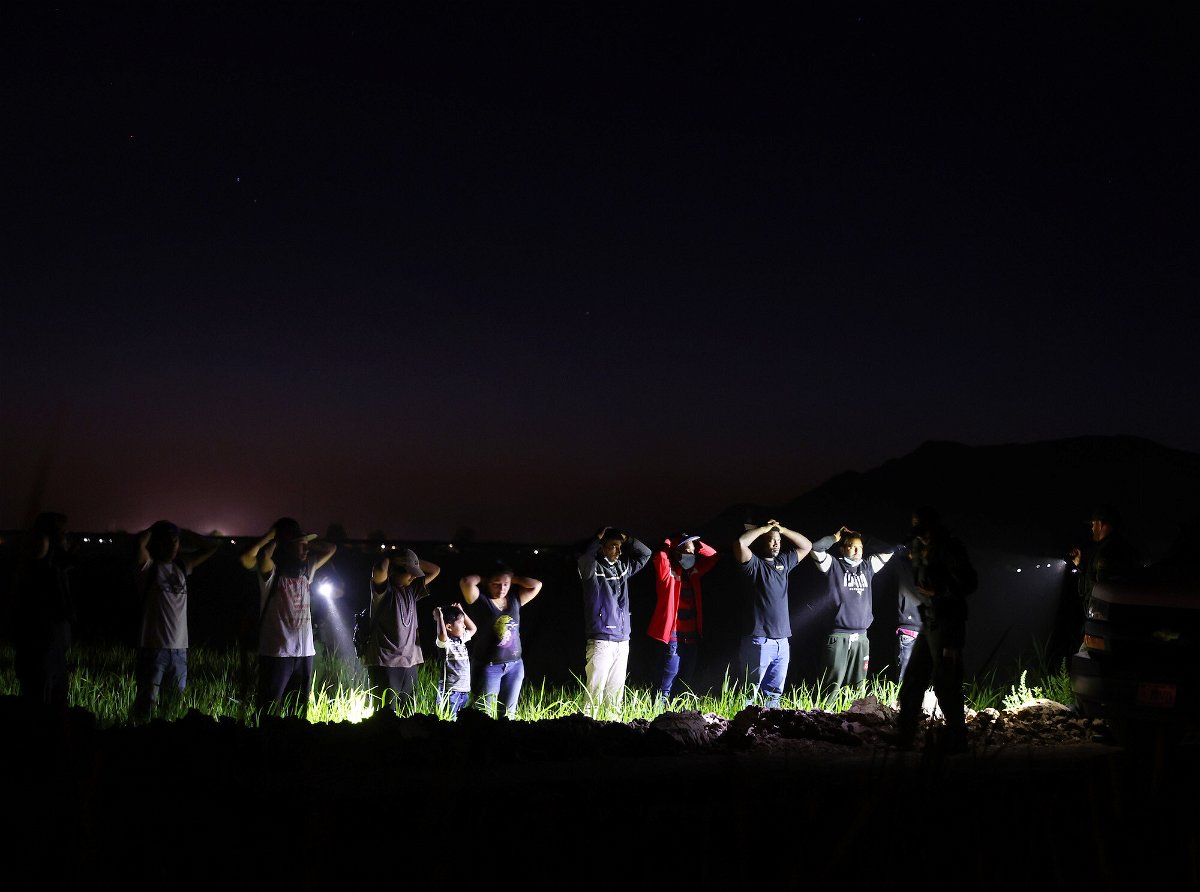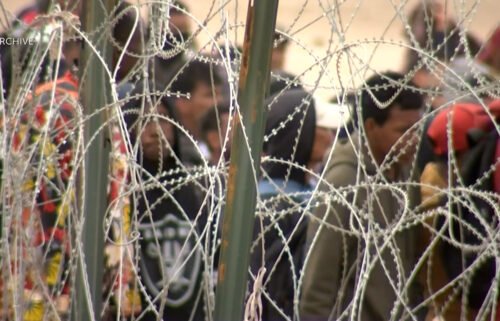Arizona’s governor is stacking shipping containers along the border and defying a federal request to remove them

Migrants are detained by U.S. Border Patrol agents on May 22 in Yuma
By Catherine E. Shoichet, CNN
Gaps in fencing along the US-Mexico border can be a dramatic — and sometimes puzzling — sight.
Miles of tall steel bollards end abruptly, giving way to open space or much smaller barriers that are designed to block vehicles from crossing, but not people.
Arizona Gov. Doug Ducey says he got tired of waiting for federal authorities to fill in the holes.
Crews at his direction started stacking shipping containers along portions of the border in August. Now the Bureau of Reclamation is asking the state to remove them — a request that Ducey’s office calls “unacceptable.”
Meanwhile, Arizona is starting to place shipping containers along another section of the border.
Here’s what we know about what’s happening, and a look at the bigger picture.
Stacked shipping containers are filling four border gaps so far
Ducey, a Republican, issued an executive order in August telling the state’s Department of Emergency and Military Affairs to use shipping containers to fill in gaps along the border. The first project: closing a 1,000-foot gap near Yuma, Arizona.
“Arizona has had enough,” he said at the time. “We can’t wait any longer.”
The 8,800-pound, 9-by-40-feet containers stand about 22 feet tall when stacked, welded together and topped with four feet of razor wire, the governor’s office said, while border fencing built during the Trump administration is about 30 feet high.
Shortly after the project began, two shipping containers toppled. A Univision reporter who shared photos of the fallen containers said contractors in the area had told her strong winds were to blame. Ducey’s office said they suspected foul play. Since then, no similar incidents have been reported, spokesman CJ Karamargin said.
By late August, 11 days after the first shipping container project began, officials announced that 130 stacked shipping containers were filling four gaps and covering more than two-thirds of a mile along the border in Arizona’s Yuma County.
That effort, Karamargin said, cost $13 million.
A federal agency says their placement is illegal and calls it trespassing
Constructing a bigger border wall was one of former President Trump’s signature priorities, and among the initiatives most criticized by his opponents. President Biden swiftly halted border wall construction once he took office.
But the Department of Homeland Security has said it plans to close small gaps in the wall. And in July, the Biden administration announced a plan to fill some gaps in the border wall near Yuma.
The Bureau of Reclamation cited those plans in a letter sent to Arizona officials earlier this month. The letter, obtained by CNN affiliate KYMA, asks the state to remove most of the shipping containers to make way for US Customs and Border Protection’s plans to fill in the gaps.
The letter says 80 containers were placed on Bureau of Reclamation land near the Morelos Dam and 42 were placed on Bureau of Reclamation rights of way on the Cocopah Indian Tribe’s West Reservation.
“The unauthorized placement of those containers constitutes a violation of federal law and is a trespass against the United States,” said the letter from Jacklynn L. Gould, a Bureau of Reclamation regional director.
Gould asked Arizona officials to remove the containers and “work with Reclamation, in consultation with the Cocopah Indian Tribe, so that CBP’s project may proceed without unnecessary delay.”
The Bureau of Reclamation did not respond to CNN’s requests for comment on the letter.
Ducey’s office says the shipping containers will stay — for now
So far Arizona isn’t backing down from the effort.
The state’s director of emergency management sent a stern response to the Bureau of Reclamation, disputing allegations that Arizona had trespassed on federal land and stating that the shipping containers would remain in place “until specific details regarding construction are provided.”
“Since December 2021, numerous federal representatives have claimed that construction on the border would begin,” Allen Clark wrote. “However, to date, Arizona has not seen any action by the federal government to do so and was therefore required to take its own action.”
Karamargin told CNN that state officials recently received a letter from CBP describing plans to use mesh fencing to fill the gaps, something he described as “completely unacceptable.”
“From Gov. Ducey’s perspective, the idea that we would take down a temporary measure so that they can replace it with a less effective temporary measure in a nonstarter,” Karamargin said.
A description of the project on CBP’s website states that construction will begin in early 2023, with plans to fill gaps “using a combination of barrier and mechanized bollard vehicle gates that allow for access to the riverside of the barrier.”
The fact that CBP construction isn’t slated to start until next year and the timing of the Bureau of Reclamation’s letter, he says, reveal how seriously federal officials are taking the situation at the border.
“We managed to fill 3,800 feet of gap in Yuma in 11 days. … It took these guys six weeks to write a letter,” he said. “They don’t seem to have a sense of urgency about this.”
Ultimately, he said, Arizona wants a permanent solution to fill the gaps — an extension of the 30-foot-tall steel border barriers. And until that happens, he said, the state will continue its efforts.
Ducey announced the next phase of the shipping container project began this week, this time in Arizona’s Cochise County, with plans to use 2,770 containers to fill a 10.25-mile wall gap.
The cost of the project is about $95 million, Karamargin said, coming from a state border security fund.
GOP governors have criticized Biden’s border policies and announced their own measures
Ducey has been Arizona’s governor since 2015.
He’s part of a vocal chorus of GOP governors — along with Texas Gov. Greg Abbott and Florida Gov. Ron DeSantis — sharply criticizing the Biden administration’s border strategy.
With midterm elections looming, the criticism has intensified, along with these governors’ highly publicized efforts to take matters into their own hands — such as state-funded buses and flights transporting migrants north to other locations in the US. The White House has called these efforts political stunts.
And Arizona’s top federal prosecutor has mocked the state’s makeshift border wall.
“We’re not dumping a bunch of shipping containers in the desert and calling it a wall to get cheap press,” US Attorney Gary Restaino wrote in an August tweet after a meeting between federal prosecutors and their Mexican counterparts. “It’s about developing comprehensive, data-driven strategies.”
Karamargin says there was a clear reason for the governor to begin the shipping container initiative this year: a marked increase in migrants crossing the border.
“None of this would be happening if the federal government took border security seriously. And clearly they are not,” Karamargin said.
Doubling down on his effort, Ducey filed a lawsuit over control of land along the border this month, asking a federal judge to effectively block federal agencies’ efforts to regulate the shipping container project. Ducey argues a 60-foot-wide swath of land known as the Roosevelt Reservation should be under state control.
The governor’s office cites numerous local officials praising the shipping container effort, and points to a Border Patrol official’s recent comment that having more gaps in the wall that migrants can cross through makes things more difficult for agents.
According to CBP data, the agency’s Yuma sector has seen the largest increase in migrant encounters over the past year — more than 170%.
In the month after the shipping containers were placed, the number of migrant encounters in the sector increased around 5%, from 24,226 in August to 25,495 in September.
This isn’t the first time border wall efforts have faced federal opposition
Efforts to erect border barriers have run afoul of federal authorities before.
In 2019 another federal body, the International Boundary and Water Commission, forced open a gate in a privately funded wall near the US-Mexico border, saying the group that built it didn’t follow proper permitting procedures.
Ultimately the commission filed a lawsuit, but construction was allowed to proceed.
In recent years we’ve seen numerous conflicts over border barrier construction, from lawsuits to political sparring.
And as large numbers of migrants keep crossing, and debates rage over how to handle the situation, we’re likely to keep seeing them erupt.
The-CNN-Wire
™ & © 2022 Cable News Network, Inc., a Warner Bros. Discovery Company. All rights reserved.
CNN’s Priscilla Alvarez contributed to this report.


